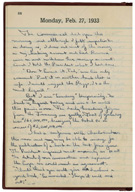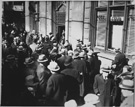Passing of an Era
Theodore Joslin - President Herbert Hoover's Last Days in Office, 1933
Some of the most harrowing moments of the Great Depression came in the final weeks of President Herbert Hoover’s administration with the collapse of the nation’s banking system in February 1933. The imminent failure of two large banks in Michigan prompted that state’s governor to declare a “banking holiday” on February 14, setting off a panic that soon infected the entire nation. During the last two weeks of Hoover’s Presidency (Franklin D. Roosevelt was sworn into office on March 4), more than $1.2 billion was taken out of the nation’s banks to be stored in mattresses, shoeboxes, and other hiding places believed to be more secure than the country’s financial institutions.
The fear and panic that gripped the nation reached all the way into the White House, where the President’s secretary, Theodore Joslin, admitted to the President that he had withdrawn money from a Washington, DC, bank that he feared was on the brink of failure; the President urged Joslin to re-deposit the money in another bank. Joslin’s diary entry recounts that conversation.
Diary of Theodore Joslin, secretary to President Herbert Hoover, February 27, 1933
The final entry for this diary is March 3, 1933, the day before Franklin D. Roosevelt was sworn into office. The final line quotes the President (described by Joslin as “angry and depressed,”) saying “'We are at the end of our string.’”
National Archives, Herbert Hoover Presidential Library and Museum, West Branch, Iowa
Excerpt:
“The Commercial [Bank] did open this morning and although I felt unpatriotic in doing so, I drew out most of the money in my checking account and had Rowena come in and withdraw her savings account. And I told the President what I had done. ‘Don’t hoard it, Ted,’ was his only comment. ‘Put it in another bank that is safe. I would suggest the Riggs. It is the most liquid.’ But I am ‘hoarding’ temporarily. No bank is really liquid today and won’t be until this panic is over. The daily hoarding figures from the Treasury are gastly. That of yesterday was $165,000,000, bringing the total to in excess of $2,200,000,000 . . .”
—From Theodore Joslin’s diary
.
Diary of Theodore Joslin, secretary to President Herbert Hoover, February 28, 1933
The final entry for this diary is March 3, 1933, the day before Franklin D. Roosevelt was sworn into office. The final line quotes the President (described by Joslin as “angry and depressed,”) saying “’We are at the end of our string.’”
National Archives, Herbert Hoover Presidential Library and Museum, West Branch, Iowa
Excerpt:
“The people are more panic stricken today than at any time since the beginning of the depression.”
—From Theodore Joslin’s diary
.
Anxious depositors in Cleveland, Ohio, learn that withdrawals are limited to five percent of their deposits, February 28, 1933
National Archives, Records of the U.S. Information Agency [306-NT-443H-1]
.
President Herbert Hoover in the Oval Office with Theodore Joslin, 1932
National Archives, Herbert Hoover Presidential Library and Museum, West Branch, Iowa [NLHH-1932-10E]
.



